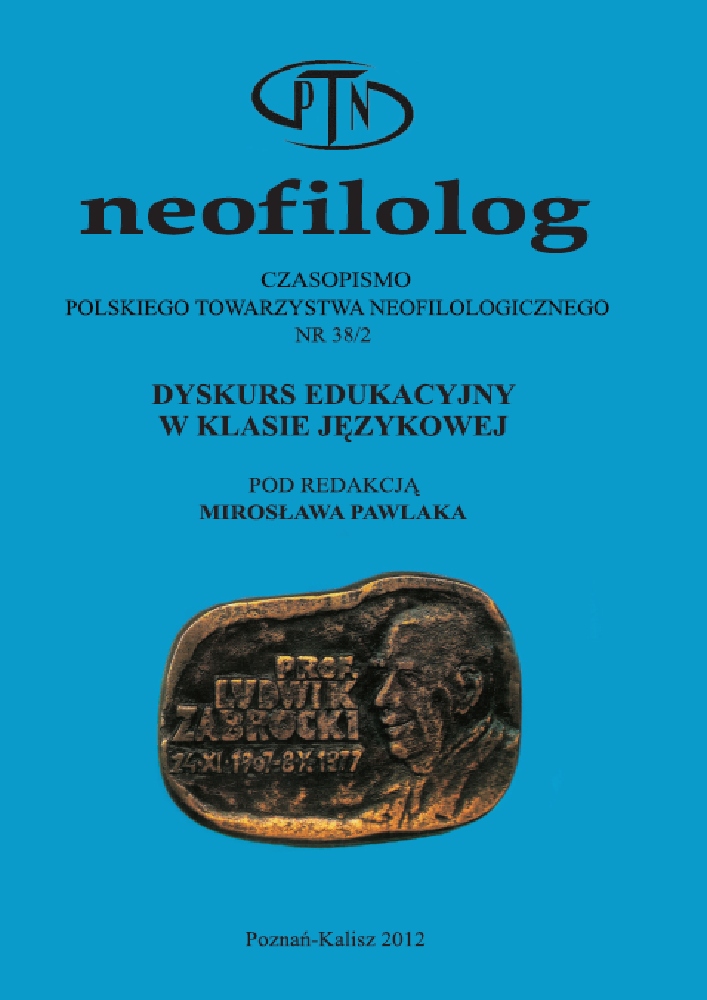Abstract
This article discusses different approaches to authentic communication, pro-posing a new definition of authentic communication in educational discourse, based on this author’ s application of Sperber and Wilson’s (1986/1995) Relevance Theory to functions of target and native language in the lan-guage classroom. According to the proposed definition, authentic com-munication in the L2 classroom refers to such uses of teachers and stu-dents’ communication which provides students both with linguistic data (positive input) and facilitates the learning process by explicitly focusing their attention on linguistic forms (negative input). After outlining some fundamental principles of Relevance Theory, the author exemplifies func-tions of the target language (English) and the mother tongue (Polish) in authentic communication in educational discourse in three stages of L2 lessons: in explicit grammar teaching, in fluency practice and in real class-room communication. Although it is claimed that the mother tongue should be preserved in monolingual teaching contexts, primarily for iden-tification and affective reasons, excessive use of the native language re-duces the target language to the function of a teaching object and, conse-quently, makes the educational discourse unauthentic.
References
Block, D. 2007. Second language identities. London: Continuum.
Breen, M. 1985. „Authenticity in the language classroom”. [w:] Applied Linguistics 6: 60-70.
Carroll, S. 1995. „The irrelevance of verbal feedback to language learning”. [w:] Eubank, L., Selinker, L. i Sharwood-Smith, M. (red.). Interlanguage: Studies in honour of W. E. Rutherford. Amsterdam – Philadelphia: John Benjamins. 73-88.
Fryc, A. 2000. „Using communicative activities in Polish secondary schools”. Nieopublikowana praca magisterska. Kraków: Uniwersytet Jagielloński.
Guariento, W. i Morley, J. 2001. „Text and task authenticity in the EFL class-room”. [w:] ELT Journal 55: 347-353.
Kramsch, C. 2009. The multilingual subject. Oxford: Oxford University Press.
Majer, J. 2003. Interactive discourse in the foreign language classroom. Łódź: Wydawnictwo Uniwersytetu Łódzkiego.
Niżegorodcew, A. 1997. „First language use in the second language classroom in the light of SLA research”. [w:] Mazur, Z. i Bela, T. (red.). New development in Eng-lish and American studies: Continuity and change. Kraków: Universitas. 631-642.
Niżegorodcew, A. 2007. Input for instructed L2 learners: The relevance of relevance. Clevedon: Multilingual Matters.
Pawlak, M. 2006. The place of form-focused instruction in the foreign language classroom. Poznań – Kalisz: Wydawnictwo Wydziału Pedagogiczno-Artystycznego UAM.
Puchała, D. 1993. „EFL classroom uses of Polish (L1) and English (L2) by non-native teachers of English”. Nieopublikowana praca magisterska. Kra-ków: Uniwersytet Jagielloński.
Przebinda, A. 2004. „Discussion or role-play? Helping secondary school learners develop their speaking skills”. Nieopublikowana praca magisterska. Kra-ków: Uniwersytet Jagielloński.
Sperber, D. i Wilson, D. 1986/1995. Relevance: Communication and cognition. Ox-ford: Blackwell.
Wilson, D. i Sperber, D. 2004. „Relevance theory”. [w:] Horn, L. i Ward, G. (red.). Handbook of pragmatics. Oxford: Blackwell. 607-632.
License
Copyright (c) 2012 Anna Niżegorodcew

This work is licensed under a Creative Commons Attribution-NoDerivatives 4.0 International License.
Authors
Authors of texts accepted for publication in Neofilolog are required to complete, sign and return to the Editorial team’s office the Agreement for granting a royalty-free license to works with a commitment to grant a CC sub-license.
Under the agreement, the authors of the texts published in Neofilolog grant Adam Mickiewicz University in Poznań a non-exclusive, royalty-free license and authorize the use of Attribution-NoDerivatives 4.0 International (CC BY-ND 4.0) Creative Commons sub-license.
The authors retain the right to the free disposal of the work.
Users
Interested Internet users are entitled to use works that have been published in Neofilolog since 2017, under the following conditions:
▪ attribution – obligation to provide, together with the distributed work, information about the authorship, title, source (link to the original work, DOI) and the license itself.
▪ no derivatives – the work must be preserved in its original form. Without the author's consent, it is not possible to distribute the modified work in the form of translations, publications, etc.
Copyrights are reserved for all texts published since 2017.
Miscellaneous
Adam Mickiewicz University in Poznań retains the property right as a whole (layout, graphic form, title, cover design, logo etc.).
